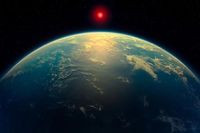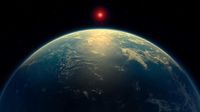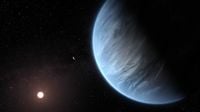Astronomers have made a groundbreaking discovery that may bring humanity one step closer to answering the age-old question: Are we alone in the universe? Using the advanced capabilities of the James Webb Space Telescope (JWST), researchers from the University of Cambridge have detected promising biosignatures on the exoplanet K2-18b, located 124 light-years away in the constellation Leo.
This research, published on April 17, 2025, in The Astrophysical Journal Letters, reveals that traces of dimethyl sulfide (DMS) and dimethyl disulfide (DMDS) have been identified in the atmosphere of K2-18b. On Earth, these chemicals are produced solely by microbial life, particularly phytoplankton, suggesting the possibility of biological processes occurring on this distant world.
K2-18b, classified as a sub-Neptune, boasts a mass 8.6 times greater than Earth and a radius 2.5 times larger. It orbits a red dwarf star every 33 days, placing it in the habitable zone where conditions may allow for liquid water—an essential ingredient for life as we know it.
Nikku Madhusudhan, the lead researcher of the study, expressed his excitement during a press conference, stating, "What we have found so far are indications of possible biological activity outside the solar system. Frankly, I believe this is the closest we have been to observing a feature that we can attribute to life." Madhusudhan emphasized the importance of caution, noting that further observations are necessary to confirm these findings.
In 2023, the same team detected methane and carbon dioxide in K2-18b's atmosphere, marking the first time carbon-based molecules were identified around a planet within a habitable zone. Previous observations had also hinted at the presence of DMS, but these signals were initially overlooked as the team focused on their primary objectives.
Upon revisiting K2-18b, the researchers utilized different instruments on the JWST to analyze the planet's atmosphere more thoroughly. This time, they found much stronger signals of DMS and DMDS, leading to a renewed hope that the planet could be teeming with life. Madhusudhan noted, "The concentration of DMS observed in K2-18b appears to be thousands of times stronger than what is found on Earth, strongly suggesting a biological origin."
Despite the excitement surrounding this discovery, the scientific community remains divided. Some experts caution against jumping to conclusions, as the presence of these chemicals could potentially arise from unknown non-biological processes. Raymond Pierrehumbert, a professor of planetary physics at the University of Oxford, expressed skepticism, suggesting that K2-18b might be too hot to support life, potentially being an ocean of lava instead.
The debate highlights the ongoing challenges in the search for extraterrestrial life, particularly in interpreting findings from distant worlds. Sara Seager, a professor of planetary sciences at MIT, emphasized the need for additional evidence before confirming the existence of life on K2-18b, stating, "It’s important to remain skeptical and to refine our methods and expectations."
As researchers continue to analyze data from the JWST, they anticipate that just 16 to 24 additional hours of observation could provide the clarity needed to confirm their findings. Madhusudhan remains optimistic, suggesting that if the association with life is real, K2-18b could be rich in various forms of life.
The implications of confirming life on K2-18b would be profound, not only for our understanding of biology but also for our place in the cosmos. If life is found to be common in the galaxy, it could reshape our philosophical and cultural perspectives, prompting us to reconsider humanity's uniqueness.
For now, the scientific community watches closely as the JWST continues its observations of K2-18b, with the hope that this distant exoplanet may soon provide the definitive proof of life beyond Earth that humanity has long sought.









